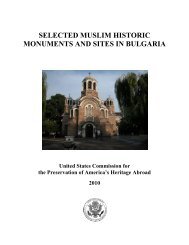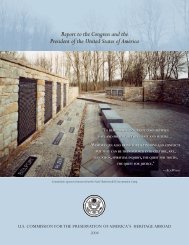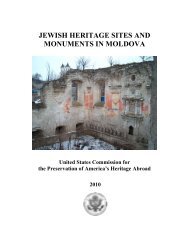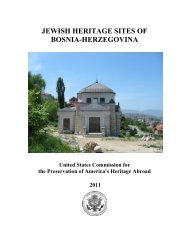jewish cemeteries, synagogues, and mass grave sites in ukraine
jewish cemeteries, synagogues, and mass grave sites in ukraine
jewish cemeteries, synagogues, and mass grave sites in ukraine
You also want an ePaper? Increase the reach of your titles
YUMPU automatically turns print PDFs into web optimized ePapers that Google loves.
The wooden <strong>synagogues</strong> of Pol<strong>and</strong> (<strong>in</strong>clud<strong>in</strong>g much of Ukra<strong>in</strong>e) rema<strong>in</strong> for many scholars <strong>and</strong><br />
architects the high po<strong>in</strong>t of synagogue architecture. These splendid build<strong>in</strong>gs, however, were<br />
almost entirely destroyed dur<strong>in</strong>g this century, mostly by German troops dur<strong>in</strong>g the Second World<br />
War. They are known today mostly through photographs <strong>and</strong> measurements made <strong>in</strong> the<br />
<strong>in</strong>terwar period by Polish architects led by Szymon Zajczyk, who did not survive the war. Many<br />
of these lost build<strong>in</strong>gs were subsequently reconstructed on paper by the Polish architects Maria<br />
<strong>and</strong> Kazimierz Piechotka, whose draw<strong>in</strong>gs cont<strong>in</strong>ue to <strong>in</strong>fluence synagogue designers today. 30<br />
Only one wooden synagogue is known to survive <strong>in</strong> Ukra<strong>in</strong>e today, <strong>and</strong> this a simple build<strong>in</strong>g of<br />
relatively late date recently documented by the Center for Jewish Art. Located <strong>in</strong> the small town<br />
of Skhidnytsia (about 30 km from Drohobych), it was built <strong>in</strong> the late 19 th century <strong>and</strong> used until<br />
the Second World War. Now used as a sew<strong>in</strong>g factory, it is one story tall <strong>and</strong> has external signs<br />
of what was once a women’s gallery. In the tradition of the earlier wooden <strong>synagogues</strong>, the<br />
build<strong>in</strong>g had a high roof <strong>and</strong> twelve w<strong>in</strong>dows. 31<br />
In the late 19 th century <strong>and</strong> early 20 th century, a large number of masonry <strong>synagogues</strong> were built<br />
<strong>in</strong> cities throughout Ukra<strong>in</strong>e. These were often three-aisle basilicas, with a theatrical-style<br />
seat<strong>in</strong>g arrangement where the congregants face the Ark located at the far end of the sanctuary,<br />
which is usually substantially longer than it is wide. Elevated galleries along three sides of the<br />
sanctuary served as seat<strong>in</strong>g for women, who were encouraged dur<strong>in</strong>g this period to participate <strong>in</strong><br />
synagogue activities. These <strong>synagogues</strong> <strong>in</strong>clude the majority of those <strong>in</strong> use today, <strong>and</strong> of those<br />
returned to Jewish communities. Some of these structures, such as the enormous synagogue <strong>in</strong><br />
Drohobych, were already overly large at the time of their construction, <strong>and</strong> they far exceed the<br />
needs of any community today. Elsewhere, however, the <strong>synagogues</strong> of this period, such as<br />
Brodsky Synagogue <strong>and</strong> the synagogue at 29 Shchekavytska Street <strong>in</strong> the Podil District <strong>in</strong> Kyiv,<br />
admirably serve the needs of substantial congregations. For the most part, these structures were<br />
decorated <strong>in</strong> an eclectic manner, deriv<strong>in</strong>g decorative patterns from historical styles, particularly<br />
the Romanesque, but adapt<strong>in</strong>g them <strong>in</strong> new fanciful ways rem<strong>in</strong>iscent of some of the commercial<br />
build<strong>in</strong>gs of Eastern Europe <strong>in</strong> the late 19 th century.<br />
An exception to this trend can be found <strong>in</strong> a group of late 19 th century <strong>synagogues</strong> designed <strong>in</strong> a<br />
more pronounced Moorish style, reflective of popular trends <strong>in</strong> Central Europe <strong>in</strong> the third<br />
quarter of the 19 th century. The style began <strong>in</strong> Dresden, where architect Gottfried Semper<br />
employed a rich comb<strong>in</strong>ation of decorative forms <strong>in</strong>spired from medieval Spanish sources –<br />
especially the Islamic decorations from the Alhambra at Granada – <strong>in</strong> the <strong>in</strong>terior of the new<br />
synagogue. While the Alhambra was hardly an appropriate Jewish provenance, neither was it<br />
Christian <strong>in</strong> orig<strong>in</strong>. Better, it recalled the “Golden Age” of Jews under Islamic Spanish rule.<br />
Semper’s attempt to identify <strong>and</strong> create a new Jewish style resonated. Over the next halfcentury,<br />
this new Spanish or “Moorish” style became <strong>in</strong>creas<strong>in</strong>gly prom<strong>in</strong>ent <strong>in</strong> synagogue<br />
design <strong>and</strong> decoration. It quickly migrated from the <strong>in</strong>terior, as at Dresden, to synagogue<br />
exteriors, as <strong>in</strong> Vienna, Budapest, Berl<strong>in</strong>, Zagreb, <strong>and</strong> elsewhere. The Moorish style was widely<br />
30<br />
See Maria & Kazimierz Piechotka, Wooden Synagogues (Warsaw: Krupski i S-ka, 1959) <strong>and</strong> a new edition,<br />
Bramy Nieba: Boznice Drewniane (Warsaw: Wydawnictwo Budownictwo i Architektura, 1996). For a discussion<br />
of the decorative programs of some of the wooden synagogue of Ukra<strong>in</strong>e, see ibid, “Polichromie Polskich Boznic<br />
Drewnianych” <strong>in</strong> Polska Sztuka Ludowa, XLIII:1-2 (1989), 65-87, <strong>and</strong> Thomas Hubka, “Jewish Art <strong>and</strong><br />
Architecture <strong>in</strong> the East European Context: The Gwozdziec-Chodorow Group of Wooden Synagogues,” Pol<strong>in</strong><br />
(Volume 10, 1997).<br />
31 “In Search of Jewish Art <strong>in</strong> Western Ukra<strong>in</strong>e,” Newsletter of the Center for Jewish Art, 14 (1998), 9.<br />
28









